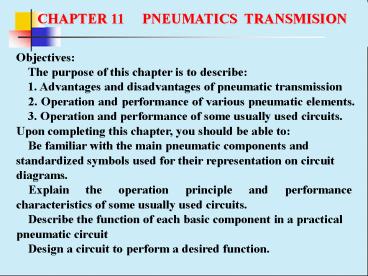Objectives: - PowerPoint PPT Presentation
1 / 15
Title: Objectives:
1
CHAPTER 11 PNEUMATICS TRANSMISION
Objectives The purpose of this chapter is to
describe 1. Advantages and disadvantages of
pneumatic transmission 2. Operation and
performance of various pneumatic elements.
3. Operation and performance of some usually used
circuits. Upon completing this chapter, you
should be able to Be familiar with the main
pneumatic components and standardized symbols
used for their representation on circuit
diagrams. Explain the operation principle and
performance characteristics of some usually used
circuits. Describe the function of each basic
component in a practical pneumatic circuit
Design a circuit to perform a desired function.
2
CHAPTER 11 PNEUMATICS TRANSMISION
11.1 Pneumatics Overview 11.1.1 Pneumatic System
Structure Its Operation Principle
In pneumatic system, compressors are used
to compress and supply the necessary quantities
of air that comes from the atmosphere. To
operate and control these actuators, other
pneumatic components are required i.e. air
service units to prepare the compressed air and
valves to control the pressure, flow and
direction of movement of the actuators.
3
Fig.11.1 A Basic Pneumatic System In production
section ?compressor, ?electric motor, ?pressure
switch, ?check valve, ?tank, ?pressure gauge,
?auto drain, ?safety valve, ?refrigerated air
dryer, ?line filter In consumption section ?air
take-off, ?auto drain, ?air service unit,
?directional valve, ?actuator, ?speed controllers
4
11.1.2 Pneumatics Properties Table
11.1.Advantages of Pneumatics
5
CHAPTER 11 PNEUMATICS TRANSMISION
Table 11.2.Disdvantages of Pneumatics
Preparation Compressed air requires good preparation. Dirt and condensate should not be present.
Compression It is not always possible to achieve uniform and constant piston speeds with compressed air.
Force requirement Compressed air is economical only up to a certain force requirement. Under the normal working pressure of 600 to 700 kPa (6 to 7 bar) and dependent on the travel and speed, the output limit is between 40000 and 50000 N.
Noise level The exhaust air is loud. This problem has now, however been largely solved due to the development of sound absorption material and silencers.
6
11.2 Air Generation and Treatment
7
11.2.1.2 Air generation equipments and preparation
8
11.2.1.2 Air generation equipments and preparation
Fig.11.5 Rotary sliding vane compressor
9
11.2.1.2 Air generation equipments and preparation
Fig.11.6 Screw Compressor
10
11.3 Actuators
11.3.1. Linear Cylinder
Fig.11.15 Construction of a Cylinder
11
11.3.2 Rotary Actuators
12
11.3.3. Air Motors
Air motors are similar in construction and
function to hydraulic motors, and are most
commonly of the rotary vane, gear, radial piston,
or axial piston type. They can operate at
speeds in excess of 10,000rpm. Air motors
have several advantages that are important in
some applications. One advantage is that air
motors can stall under full load for indefinite
periods of time, another is that they can be used
in applications where electric motors would
constitute a fire hazard.
13
11.4 Pneumatic Control Valves
11.4.1 Pressure Control Valves
Fig.11.20 Safety Valve
14
11.4.3 Directional Control Valves
15
11.5 Basic Pneumatic Circuits































